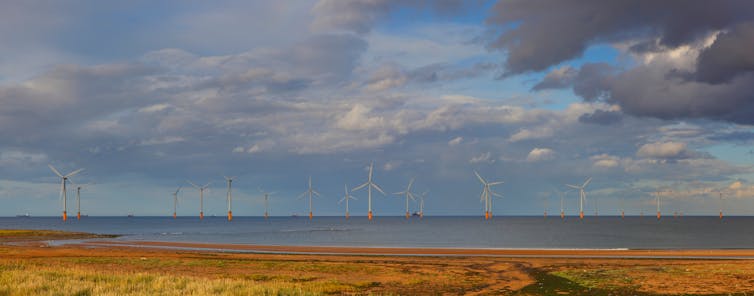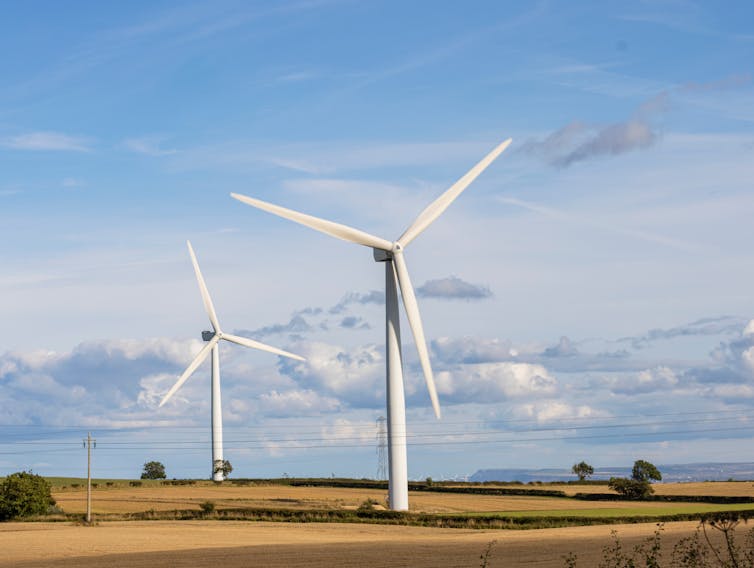In a packed auditorium in Liverpool, Labour leader Keir Starmer stood at a plinth emblazoned with the words “A Fairer, Greener Future”. It was the key theme of this year’s party conference and is evident in Starmer’s landmark policy announcement: the creation of a new publicly-owned energy company, Great British Energy.
The company would effectively be a start-up to grow British renewables. So while Great British Energy is not nationalisation of the electricity sector (or of any one energy company), it would represent a new and different sort of organisation positioned to fund new projects while working to remove the hurdles faced by new wind and solar projects.
This follows calls from various organisations for a new way of generating and providing electricity. For many, the scale of action needed to both reach net zero and address energy poverty is incompatible with the current model of doing things, which focuses on paying shareholders and avoiding riskier investments.
Like EDF in France or Vattenfall in Sweden, Great British Energy would be state-owned. But it would be independent, making its own investment decisions and working closely with private energy companies.
Being backed by the government, the new company can take on riskier investments. This might be in bigger projects or in new, innovative technologies such as tidal energy. Rather than paying shareholders, the profit that this company makes can then be reinvested in new projects, or for cutting bills or insulating homes.
Great British Energy is one part of a broader approach that Labour has put forward, including measures on energy efficiency and an £8 billion national wealth fund to help decarbonise industry.
The public supports public energy
Despite some concerns about how these policies might be sold on the doorstep, there is public support. Polling in May 2022 showed that 60% of UK voters support bringing energy companies into public ownership – and such patterns of support have remained relatively constant.
Popular campaigns have called for nationalising the sector. Others have highlighted how the current system prioritises shareholders over addressing energy poverty.

Colin Ward/Shutterstock
When Labour raised a similar policy in the 2019 election, it was treated as foolish by much of the media. Yet Russia’s invasion of Ukraine and its aggressive use of disruptions to its natural gas exports to Europe as a political weapon have changed energy politics in Europe.
Those calling for the expansion of renewable energy used to highlight how they were greener and cheaper than fossil fuels. Events in 2022 have now made renewables the basis for energy security too.
Who makes decisions, and who benefits from them?
While this policy pledges a different type of energy company, being state-owned does not make any organisation inherently “good”. For instance, EDF in France has been caught spying on Greenpeace. Elsewhere, Vattenfall has sold off its coal power stations rather than replacing them with renewables, merely shifting emissions on to somebody else’s balance sheet.
Addressing these issues requires a reflection on who is making decisions. The proposed national wealth fund would include co-investments with private companies. But who would be involved in directing these investments and who might benefit from them?
Hydrogen energy was mentioned in several speeches at Labour’s conference, and the industry’s lobbyists were reported to have been active and hosted meetings. However, recent work has shown that any move to use hydrogen for home heating is likely unviable.
Elsewhere at the conference, climate campaigners accusing Drax, the biggest emitter in the UK, of environmental racism were reportedly removed from a meeting on net zero and green jobs.
A national energy company must also wrestle with where new renewable energy projects, which tend to demand large tracts of land, will be built and who might suffer from the impacts. Compensation payments in the UK have rewarded unfair patterns of land ownership and the monopolisation of land by the rich and the powerful.
In the UK, a small number of landowners stand to gain financially from the expansion of onshore wind, while offshore wind power is permitted by the crown estate which owns the seabed.

Traceyaphotos2/Shutterstock
Those living nearby often receive limited compensation. In Scotland, communities living near onshore wind turbines get 0.6% of the value of electricity generated.
This does very little to address regional issues of inequality or exclusion. Community-owned projects have a better track record, providing up to 34 times the financial benefits of those built by private energy companies.
Great British Energy is a policy that many voters will support. While there remain questions about the forms it might take and how it might change the energy sector, it represents an opportunity to generate and use energy differently – as long as it is part of a broader, just energy transition.
These policies are coming at a time of spirallling energy costs and energy poverty for millions, and any national energy company must make addressing this a priority. Labour’s energy efficiency plans show that the party is intent on doing so. The cheapest electricity is the electricity that we don’t use, after all.
It is also politically savvy: some of the areas worst affected by energy prices are in marginal seats. A national energy company playing a central role in funding and directing renewable schemes would allow them to be better targeted, would allow funding for unprofitable projects, and any financial returns could be used to further support families and communities.
But there is still room for Labour to be more ambitious. Great British Energy could be the first step towards an inclusive energy transition, but we must think about what comes next.![]()
——————————-
This blog is written by Cabot Institute for the Environment member Dr Ed Atkins, Senior Lecturer, School of Geographical Sciences, University of Bristol. This article is republished from The Conversation under a Creative Commons license. Read the original article.
 |
| Ed Atkins |







